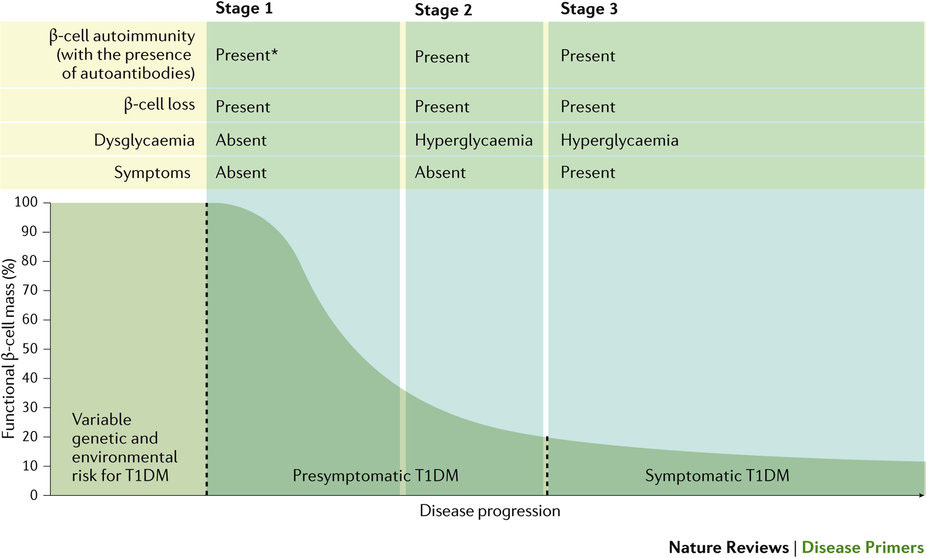1型糖尿病
Type 1 diabetes mellitus
2017年3月30日 Nature Reviews Disease Primers Article number: 17016 (2017) doi: 10.1038/nrdp.2017.16

自己免疫性糖尿病としても知られる1型糖尿病(T1DM)は、膵β細胞の破壊によるインスリン欠乏を特徴とし、高血糖をきたす慢性疾患である。通常、小児期または青年期に発症するが、それよりも後に症状が現れることもある。T1DMの原因は完全に解明されていないが、この疾患の病因はβ細胞のT細胞媒介性破壊と考えられている。インスリン、65kDaグルタミン酸デカルボキシラーゼ、インスリノーマ関連タンパク質2および亜鉛輸送体8(いずれもβ細胞の分泌顆粒に関連するタンパク質である)を標的とする膵島関連自己抗体は、T1DM関連自己免疫のバイオマーカーであり、発症の数カ月から数年前に出現するためT1DMの発症リスクを有するヒトの同定および研究に使用できる。どのタイプの自己抗体が最初に出現するかは環境要因や遺伝的要因に依存している。T1DMの病因は、高血糖および高血糖関連症状(多尿、喉の渇きなど)の有無に応じて3つに分けることができる。治癒は困難とされており、患者は生涯、インスリン注射を行う必要がある。現在、インスリンポンプ、持続血糖測定およびハイブリッドクローズドループシステムなどのインスリン治療の新しいアプローチが開発中である。厳格な血糖コントロールにより細小血管合併症や大血管合併症の発生率は低下したものの、依然としてT1DM患者の大部分にこれらの合併症が発現している。早期診断を実現して、β細胞の破壊を予防することに加えて、より良い治療選択肢を開発してQOLや予後の改善を図るには、さらなる研究努力が必要である。
PrimeView
1型糖尿病(T1DM)は、膵β細胞の破壊によるインスリン欠乏を特徴とする慢性疾患である。このPrimeViewでは、免疫機構を介する膵β細胞の破壊を含め、T1DMの基礎となる発症機構を中心に取りまとめる。
本Primerの図解サマリー
Type 1 diabetes mellitus (T1DM), also known as autoimmune diabetes, is a chronic disease characterized by insulin deficiency due to pancreatic β-cell loss and leads to hyperglycaemia. Although the age of symptomatic onset is usually during childhood or adolescence, symptoms can sometimes develop much later. Although the aetiology of T1DM is not completely understood, the pathogenesis of the disease is thought to involve T cell-mediated destruction of β-cells. Islet-targeting autoantibodies that target insulin, 65 kDa glutamic acid decarboxylase, insulinoma-associated protein 2 and zinc transporter 8 — all of which are proteins associated with secretory granules in β-cells — are biomarkers of T1DM-associated autoimmunity that are found months to years before symptom onset, and can be used to identify and study individuals who are at risk of developing T1DM. The type of autoantibody that appears first depends on the environmental trigger and on genetic factors. The pathogenesis of T1DM can be divided into three stages depending on the absence or presence of hyperglycaemia and hyperglycaemia-associated symptoms (such as polyuria and thirst). A cure is not available, and patients depend on lifelong insulin injections; novel approaches to insulin treatment, such as insulin pumps, continuous glucose monitoring and hybrid closed-loop systems, are in development. Although intensive glycaemic control has reduced the incidence of microvascular and macrovascular complications, the majority of patients with T1DM are still developing these complications. Major research efforts are needed to achieve early diagnosis, prevent β-cell loss and develop better treatment options to improve the quality of life and prognosis of those affected.

